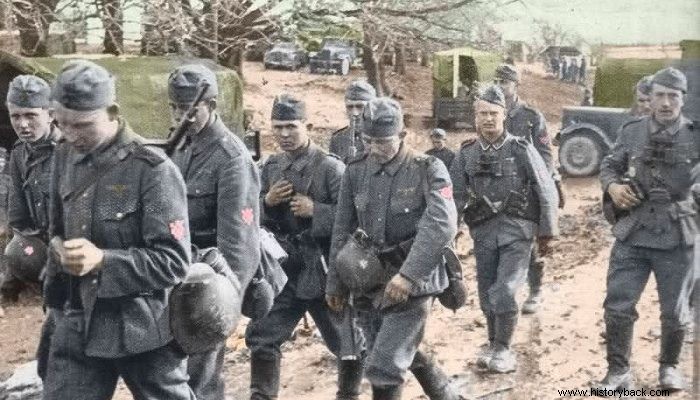
Croatia was an Italian-German satellite state created after the breakup of Yugoslavia in April 1941. Its murderous fascist leader Ante Pavelic ordered the formation of Croatian armed forces to reinforce his Axis allies and overlords. The last Croatian Infantry Division (IP) to be formed was the 392nd. The division began to be formed on August 17, 1943 and was named "The Blue".
Organization, organization and... escape
Its commander was Major General Johann Mikl, a veteran officer of the Austro-Hungarian Army during World War I. Again most of the officers and non-commissioned officers were German. A total of 3,500 Germans and 8,500 Croats joined the division , coming mainly from the National Guard. The division had two infantry ("grenadier") regiments, the 846th and 847th, a reconnaissance battalion, a tank hunter, engineer, transmission and service battalion, as well as the 392nd Artillery Regiment.
Training lasted until December 1943 and in early 1944 the division was concentrated in Zagreb and Karlovac and then deployed from the Dalmatian coast of Slovenia to the town of Knin in the Croatian hinterland. The division joined the German XV Mountain Corps (SS), initially based in Karlovac. Fearing an Allied landing on the Dalmatian coast, the German command assigned the division to guard the coast in the area from Rijeka to Karlobag, on a 60 km front without relieving it of the task of covering the vital Karlovac-Seni road , nor the mission to cover the Zagreb – Karlovac railway line.
It is understandable that even if the division had superhuman soldiers it could not carry out all these missions at once with its seven infantry battalions in an area teeming with partisans. On January 13, 1944 the 847th Grenadier Regiment (Sgr) moved towards Ogulin with the aim of lifting the siege of the garrison there. However, against the experienced partisans, the Croatian national guards who mainly manned the division had no luck. At the first impact, the Croats panicked and fled, leaving the Germans alone to fight.
German casualties were particularly heavy and most officers and non-commissioned officers of the regiment were killed or wounded. After a short reorganization a new attempt was made and finally the siege of Ogulin came on January 16, 1944. Continuing the clearing operations the division restored its reputation by overpowering the experienced 13th Assault Division of the Yugoslav People's Liberation Army (JLA) and capturing ammunition and supply depots.
Clashes with the partisans
After this success the 846th SG was allocated to the security of the division's lines of communication, while the 847th SG, together with the artillery and pioneers, was deployed on the coastline in anticipation of an Allied landing which never took place. Partisans constantly harassed the division and especially the 846th Sgr, whose positions were also the target of allied aerial bombardments from Italy.
At the end of February, the 847th SR along with an Ustasi battalion attempted to clear the area south of Ogulin, but due to the snow and the cutting of its line of communication by the partisans, it was forced to retreat, suffering losses. In March the 847th SR captured the Dalmatian islands of Rab and Pag, without resistance, as the partisans had withdrawn. At the same time, the 846th Sgr, together with units of the national guard, was operating in the area of the Gaska river valley. The division managed to control its area of responsibility, also repelling an attack by the partisans against Ottokats.
In mid-April, Lieutenant General Mickle ordered a large-scale operation against the 13th Assault Division of the GLAS. The attack was undertaken by the 846th Infantry Division, reinforced by parts of the 847th and the entire divisional artillery, as well as a battalion anti-aircraft. The partisans had turned the village of Dreznitsa into a supply center. There they had also stored a large number of Italian weapons that had come into their possession after the capitulation of the weak Axis partner.
The operation lasted two weeks and was successful. Only the light armament captured was enough to equip two divisions! Also seized were 30 tons of small arms ammunition and 15 tons of artillery shells. The partisans responded with an attack by the 35th Division of GLAS, which was relatively successful. Mickle soon fought back, but the results were not significant. In the meantime the division was reinforced with 500 Germans and formed a solid battalion.
The end
After the capture of Knin by the partisans, the division was used by the German administration, in January 1945, to man the defense line Otokacs – Bihacs. However this line could not be held as Tito had gathered his 4th Army opposite and from the beginning of spring he was pressing hard. At the beginning of April 1945, the 392nd MP began to retreat westward under pressure from its opponents, arriving, in the middle of the month, in the area of Rijeka. During the retreat, on April 9, the division lost its commander, who was shot in the head and died the next day.
On April 24, the German command decided to disarm and remove all Croats from the division. Only a few trusted ones remained in its dwindling ranks. Then the bulk of the division was handed over to Tito's forces. Several of the Croats who demobilized, knowing the fate that awaited them at the hands of the partisans, joined the Croatian Army which now belonged to the Chetnik forces. Eventually these men retreated to Italy and surrendered to the British. What was left of the division was handed over, on May 7, to GLAS.
